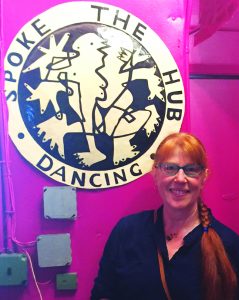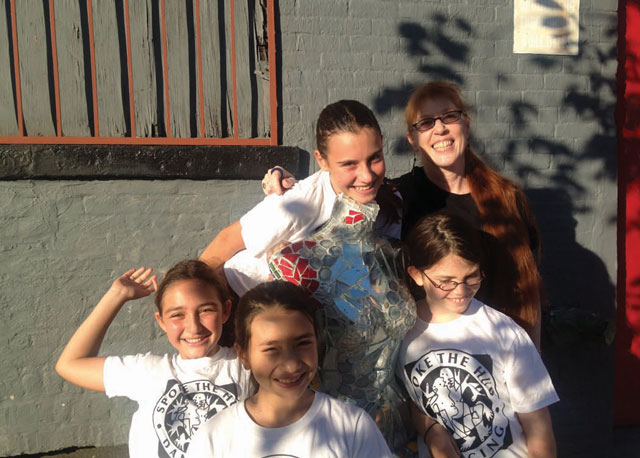 For our second Slope Survey—inspired by Marcel Proust and his eponymous questionnaire—we turned to longtime Park Slope resident and Founder/Director of Spoke the Hub Dancing, Elise Long.
For our second Slope Survey—inspired by Marcel Proust and his eponymous questionnaire—we turned to longtime Park Slope resident and Founder/Director of Spoke the Hub Dancing, Elise Long.
What brought you to Park Slope? I was living on the Lower East Side in the late 70s. My fiancé felt it was too unsafe and refused to join me there; maybe it was, but it was all I could afford. We then received a brunch invitation from friends renting a brownstone floor-through on Prospect Park West. It felt like a mansion, with stained glass windows and beautiful woodworking. It wasn’t much more expensive than my tiny, roach–infested hovel off Avenue A with the bathtub in the kitchen and toilet in the hall. Also, considering the amenities of Prospect Park, the library, Botanic Gardens, BAM, the Brooklyn Museum, and relatively cheap rents (yes!), our decision to cross the river was a no-brainer, a decision I’ve never regretted. What is your most memorable Park Slope moment? My most memorable moment in recent times, which happened to be in Park Slope, was that gorgeous blue-skyed morning of 9/11: first hearing the sirens, then watching the smoke and towers tumble from my roof, searching for lost friends, lining up (and being turned away) at Methodist Hospital where I tried to offer my rare O negative blood, and the following unsettling days and weeks. I was—and still am—grateful for my steadfast Park Slope community of friends and neighbors. A good day for you is … Minimal time on the computer! Describe your community superpower. I think I’m pretty successful at bringing diverse communities together and persuading reluctant bodies of all ages onto dance floors to do the Brooklyn boogaloo. If you could change one thing about the neighborhood, what would it be? Less real estate offices and nail salons, please. That’s two things, but you get my drift. What do you think Park Slope will look like in 10 years? in 20 years? How I’d like the neighborhood to look is different than how I think it will actually look. 4th Avenue will probably be like Park or Madison Avenue, flanked by a Grand Canyon of giant building complexes. But hopefully there’ll be more green spaces and mature trees to balance those concrete citadels. What were your childhood nicknames? I have always had to put up with “Carrot Top/Gingy/or Hey Red!” from strangers. My mom still calls me Leela, don’t ask me why. What is your greatest extravagance? Orchestra seats at BAM every now and then. Or traveling around the world. I’m saving up for Bhutan. If you couldn’t live in Park Slope or in Brooklyn, where would you go? I can’t imagine NOT living in Park Slope, but I spend a lot of time in Philly. I do love all the rivers, parks, history, and public art works gracing that fair city. I also feel like I could be the love child of Isaiah Zagar, the manic mosaic creator of the Magic Gardens, so maybe I have legitimate Philly DNA. Who is your hero, real or fictional? As a kid, Abe Lincoln was my imaginary “friend” and most-admired hero. We must’ve been studying the Civil War in school and he caught my imagination. I used to take him on imaginary tours around our house in California to show him modern day conveniences. I’d show him our kitchen faucets—wasn’t it amazing that we had hot running water on demand? I told him if you put a letter in the mailbox, it’d end up at Grandma’s house across the country in a few days. I demonstrated the use of zippers, telephones, washers and dryers, radios, and TV’s. He was very impressed, and I was pleased to impress him with all these modern day inventions and quality of life “things” we as a people had produced post-Reconstruction. After reading Team of Rivals as an adult, he became my hero all over again, but I no longer give him house tours.

 It’s Friday morning yoga, and my fellow classmates and I are congregating in the waiting room at Spoke the Hub. The toddler dance class before us lets out, and for a few chaotic moments, we are overtaken by a swarm of excited 3-year-olds that seem to swim through us in the mosaic-tiled fishbowl.
It’s Friday morning yoga, and my fellow classmates and I are congregating in the waiting room at Spoke the Hub. The toddler dance class before us lets out, and for a few chaotic moments, we are overtaken by a swarm of excited 3-year-olds that seem to swim through us in the mosaic-tiled fishbowl.